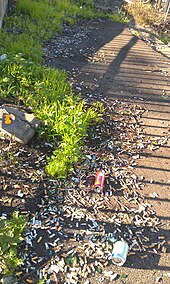
Summary
Litter in Australia is prevalent in many areas and a significant environmental problem, particularly in the large cities of Sydney and Melbourne. In 2023, plastics make up 81 per cent of all surveyed litter.[1]



History edit
An anti-litter movement began in 1969 in Victoria with the formation of Keep Australia Beautiful. Its major anti-littering campaigns "Do the right thing" and "Tidy Towns" became well known nationally. Today, the most vocal organisation is Clean Up Australia which holds a national clean up day.
There is currently no national legislation against litter, because the federal government is not authorised by the Constitution to legislate on such a subject.
It is considered the responsibility of either States and territories of Australia or Local Government Areas. All states and territories now have legislation against littering which may include fines that are enforceable by the police or other agents.
Littering is one of the reasons that around 130,000 tonnes of plastic end up in Australian waterways.[2]
In 2006, the most commonly littered item was cigarette butts, followed by items made from paper and cardboard with plastic items a close third.[3]
In 2015, Victoria was the state with most littering followed by Queensland.[4]
Definition edit
Litter generally describes something that has been put where it is not meant to be.[5] It can be solid or liquid and come from domestic or commercial use.[6]
Victoria edit
In Victoria, the first legislation included the Environment Protection Act (1970) and later the Litter Act (1987).
The responsibility to enforce the regulation is divided between EPA Victoria, Victoria Police, local governments, VicRoads, Parks Victoria and Melbourne Water.[3]
The Environment Protection Authority (Victoria) was the first to facilitate report littering online (based on vehicle registration details) by introducing the appropriate legislation and dispense fines. EPA was also the first in Australia to create a public litter reporting service in 2002.[7]
In 2015-16, more than 75 per cent of reports submitted to EPA Victoria by the public were about people discarding cigarette butts from their cars and 60% of offenders were male. Altona, Melbourne and Altona North were the three areas were the most littering was reported.[8]
Reporting pollution is a general environmental duty held by all Victorians and incorporated in Victorian law since 2018 and it includes reporting littering.[9]
As of 2024, fines for littering can go up to $769 for individuals and $3846 for corporations.[10]
Northern Territory edit
Northern Territory followed Victoria and adopted the Litter Act (1972).
South Australia edit
In South Australia the Container Deposit Legislation (1977) was introduced with the aim of reducing litter by encouraging recycling and remains the only state in Australia with this type of legislation.[11]
Western Australia edit
Anti-litter legislation was introduced to Western Australia through the Litter Act (1979).
Australian Capital Territory edit
Litter legislation was introduced to the Australian Capital Territory with the Litter Regulations (1993).
Queensland edit
In Queensland, litter laws first came into place through the Environmental Protection Act (1994).
New South Wales edit
In New South Wales, legislation was introduced through the Protection of the Environment Operations Act 1997.
Tasmania edit
In Tasmania, anti-litter legislation was introduced through the Litter Act (2007).
See also edit
- Environmental issues in Australia
- Container deposit legislation in Australia (container deposit legislation is an effective measure for reducing litter)
- Waste Management in Australia
References edit
- ^ "Litter Reports". CleanUp Australia. Retrieved 13 March 2024.
- ^ Murray-Atfield, Yara (27 December 2019). "Australians create 67 million tonnes of waste each year. Here's where it all ends up". ABC News. Retrieved 19 December 2023.
- ^ a b "Litter Management in Australia" (PDF). National Environment Protection Council. November 2008. Retrieved 19 December 2023.
- ^ Review, Waste Management (2016-02-23). "Victoria named most littered state in Rubbish Report 2015". Waste Management Review. Retrieved 2024-01-30.
- ^ EPA and State Government of Victoria (April 2000). "Publication 692 "Don't put up with this rubbish, make litterers pay"".
- ^ Parliament of Victoria. Litter Act 1987.
- ^ "Keep Cleaning Up Your Act Victoria | Premier of Victoria". www.premier.vic.gov.au. Retrieved 2024-02-05.
- ^ "Keep Cleaning Up Your Act Victoria | Premier of Victoria". www.premier.vic.gov.au. Retrieved 2024-02-05.
- ^ Victoria, Environment Protection Authority. "Report litter and pollution | Environment Protection Authority Victoria". www.epa.vic.gov.au. Retrieved 2024-02-05.
- ^ Victoria, Environment Protection Authority. "Report litter from vehicles | Environment Protection Authority Victoria". www.epa.vic.gov.au. Retrieved 2024-02-05.
- ^ "Fact Sheets - Container Deposit Legislation (CDL)". www.kesab.asn.au. Archived from the original on 2007-08-31.


